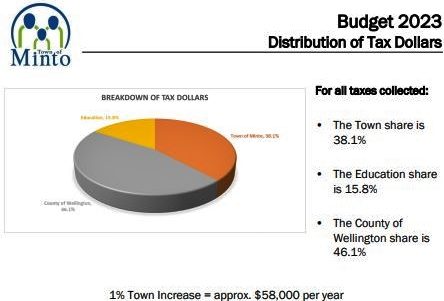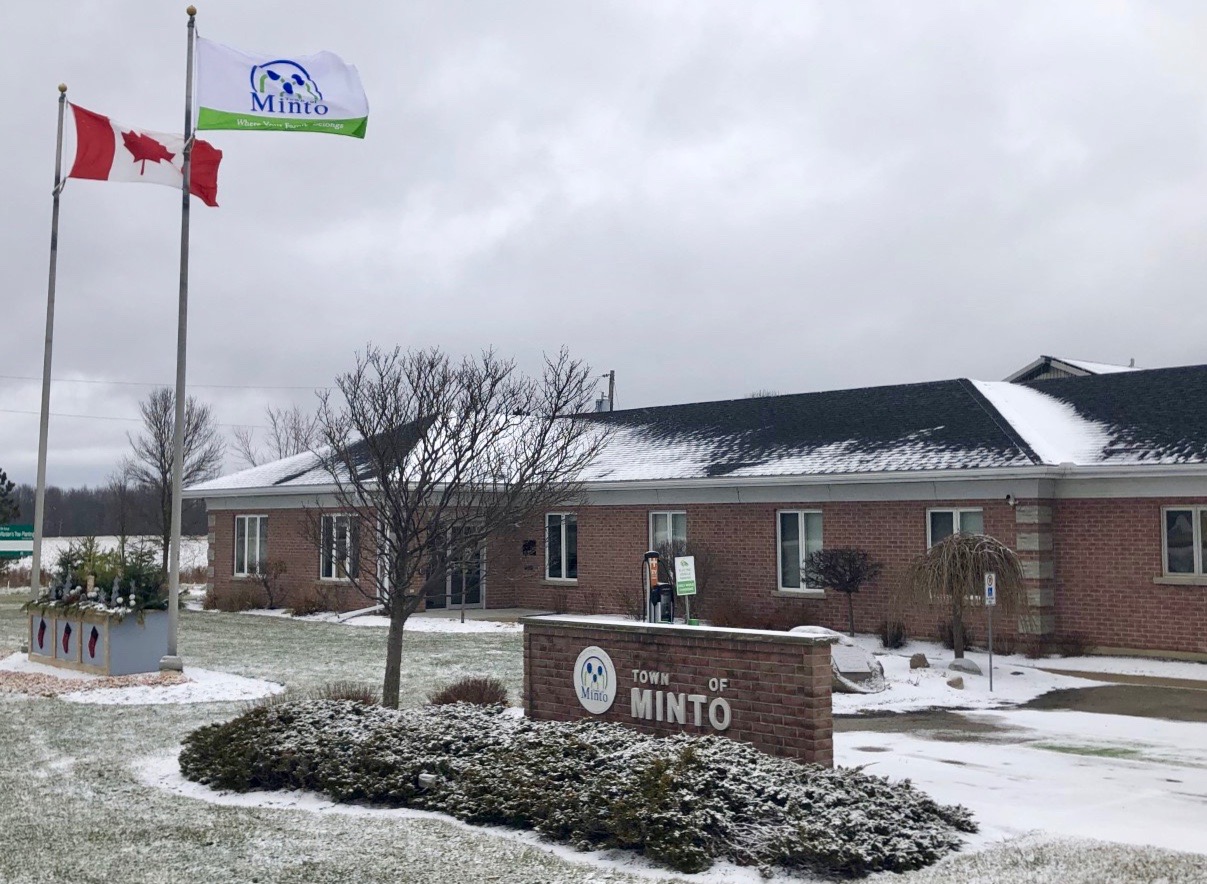MINTO – An early draft of the Town of Minto’s 2023 budget shows the municipality’s total tax levy rising by 4.88 per cent and the local tax rate increasing by 1.88%.
That means the Town of Minto portion of the typical tax bill would rise by about $24.
When combined with projected county (1.75%) and school board (0%) tax rate increases, Minto taxpayers could be expected to pay about $21 more per $100,000 worth of assessment in 2023, or about $52 on a home with the typical residential assessment of $250,000.
At a Jan. 17 meeting on the operating portion of the budget, treasurer Gordon Duff pointed out that given disparities in assessment across Wellington County and a lag in current value assessment generated by the Municipal Property Assessment Corporation, assessment values don’t reflect true property values.
MPAC’s scheduled reassessment program was paused during the COVID-19 pandemic, meaning the province is in “the seventh year of a four-year cycle.”
“I always like to preface that $100,000 in Minto is not $100,000 in Puslinch,” Duff noted.
“Because even at today’s values, that’s probably a quarter to a fifth of an actual house. And it’s probably way less than 10% of an actual house’s value in the south end of the county.”
He continued, “Our mythical typical average residential house, which I realize is well below market value, but that is assessed value … we’re saying that’s about $250,000. So the 4.88 is roughly $24 per household (for the Minto portion only).”
Budget documents note the town receives 38.1% of every tax dollar collected, with, 46.1% going to the county and 15.8% per cent to education.
“It’s going to be a tough year. Everybody knows all about some our obstacles in reference to CPI (Consumer Price Index) and inflation and fuel prices and chemical prices and salt, all the other items …” said Mayor David Turton.’
“We had that same issues down at the county as well last week when we were talking about the budget.”
“The town is facing inflationary pressures in almost all areas of operation,” noted deputy treasurer and acting co-CAO Mark Potter.
“With the increased cost of fuel, materials, outside services and insurance premiums, staff have continued to look for efficiencies in the delivery of the important services,” Potter added.
Treasurer Gordon Duff suggested assistance from upper levels of government will be needed to help municipalities deal with inflationary pressures.
Duff noted that earlier in the day he had the opportunity to speak to provincial finance minister Peter Bethlenfalvy.
“I did mention that today I’d be presenting, I believe, my 22nd budget for the town of Minto and this has been by far the most challenging,” Duff stated.
He said he outlined for the minster the town’s position in terms of tax levy and future budget projections compared with “what our asset management plan says it should look like,” and the town’s current levels of debt and recent tax increases.
The assessment management plan indicates, on a replacement cost basis over a 10-year period, $7.9 million should be spent annually to maintain core assets such as roads, bridges, stormwater and water/wastewater assets.
An addition $4 million is needed annually for other assets the plan indicates.
“We’re committed and our taxpayers and ratepayers are tapped out and we need help from our partners who have access to much more revenue than we do,” said Duff.

The Town of Minto’s draft budget projects a 4.88% increase in the tax levy for 2023. Town of Minto agenda image
In recent years, Minto officials have chosen a theme for the annual budget process with 2023 designated “A Year of Planning.”
“Staff will embark on updating various plans that will position the town for success in the years to come,” said Potter.
A quote from author and personal time management specialist Alan Lakein – “Planning is bringing the future into the present, so that you can do something about it now” – was one several maxims offered by Potter to illustrate the budget theme.
The town’s human resources policy calls for a staff cost-of-living allowance increase at 6.9% (based on the September CPI) and Duff said raw inflationary pressures on the budget, including increases in fuel and energy costs, insurance and staffing, would push the levy increase as high as 12% if mitigating steps are not taken.
“We do not feel that is acceptable. And I’m sure our residents don’t either. So what we’re proposing is to cap the COLA increase to 4% (saving just over $131,000),” said Duff.
“It’s a real fine line between staff retention and being fiscally responsible … So we are proposing a 4% cap for ‘23 with the option to carry forward the 2.9 to a future year.”
Increased assessment will also help mitigate the potential increases and “the rest is, basically its manoeuvring money to and from reserves,” Duff explained.
Tapping reserves to the tune of just over $200,000 “is nothing anybody wants to do,” said Duff.
“But if it’s a rainy day, it’s a rainy day,” he added.
In dollar terms, the draft budget shows the 2023 tax levy (the amount supported by taxes as opposed to other revenue sources) rising by $281,200 to $6,039,800, from 5,758,600 budgeted in 2022.
The draft budget anticipates spending of:
- $2,347,000 on public works, up $154,000 or 7% from 2022;
- $1,668,000 on administration, down $19,900 or 1.18%;
- $1,659,000 on community services, up $142,000 or 9.36%;
- $1,096,800 on fire and emergency services, up 74,600 or 7.3%;
- $490,200 on economic development, a decrease of $40,700 or 7.67%; and
- $346,100 on building and planning services, down $27,000 or 7.24%.
Economic and community development director Belinda Wick-Graham noted the budget reduction in that department will come largely through a reduced allocation to the municipality’s Community Improvement Program (CIP).
“We are dropping our CIP Loan Program grant program down by about $30,000,” she explained.
“Last year, we didn’t see as much uptake. So we have lowered that this year, knowing the challenges that our businesses are having many struggling to stay open for a variety of reasons.
“We’re not hopeful that this will have a big uptake this year either.”
The town’s insurance premiums are expected to rise by $58,000 to $649,800, resulting in a 1% impact on the overall levy.
“We do have a significant portion of the town’s insurance premium fall under our budget and so we’re anticipating a significant increase to our insurance as well,” noted community services manager Matt Lubbers.
A year of regular program operation could help the department’s bottom line, he suggested.
“In terms of program delivery and special event facilitation, we just like to have a normal calendar year without a shutdown, a lockdown or proof of vaccination or any of that terminology,” Lubbers said.
Duff pointed out the municipality’s allocation from Ontario Municipal Partnership Fund – unconditional grant funding provided by the province – will decrease by 2.2%, from $1,525,500 in 2022 to $1,492,300 this year, a reduction of $33,200.
“It’s about where it was 10 years ago, but at least it’s still there,” said Duff.
“I think the government has heard the message that this is a very important program.
“And I know there was talk about five years ago, they were phasing it out, but certainly ourselves and many other municipalities really depend on that.”
The drop in OMPF allocation is more than offset by an increase in the town’s Ontario Community Infrastructure Fund grant. The allocation will rise from $994,250 this year to $1,143,388 in 2023, an increase of $149,138.
“So we are up in grants by $115,000, which is very good. But $115,000 doesn’t go as far as it used to either,” said Duff.
The town’s next budget meeting, set for Feb. 17, will focus on capital programs and updates to the operational budget.
A public budget open house is planned for March 7.




